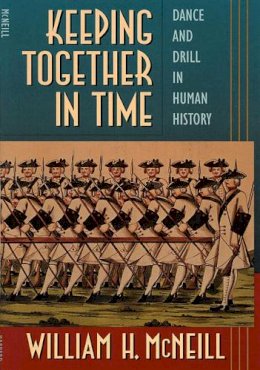
Keeping Together in Time
William H. McNeill
Could something as simple and seemingly natural as falling into step have marked us for evolutionary success? In Keeping Together in Time one of the most widely read and respected historians in America pursues the possibility that coordinated rhythmic movement--and the shared feelings it evokes--has been a powerful force in holding human groups together.As he has done for historical phenomena as diverse as warfare, plague, and the pursuit of power, William H. McNeill brings a dazzling breadth and depth of knowledge to his study of dance and drill in human history. From the records of distant and ancient peoples to the latest findings of the life sciences, he discovers evidence that rhythmic movement has played a profound role in creating and sustaining human communities. The behavior of chimpanzees, festival village dances, the close-order drill of early modern Europe, the ecstatic dance-trances of shamans and dervishes, the goose-stepping Nazi formations, the morning exercises of factory workers in Japan--all these and many more figure in the bold picture McNeill draws. A sense of community is the key, and shared movement, whether dance or military drill, is its mainspring. McNeill focuses on the visceral and emotional sensations such movement arouses, particularly the euphoric fellow-feeling he calls "muscular bonding." These sensations, he suggests, endow groups with a capacity for cooperation, which in turn improves their chance of survival.
A tour de force of imagination and scholarship, Keeping Together in Time reveals the muscular, rhythmic dimension of human solidarity. Its lessons will serve us well as we contemplate the future of the human community and of our various local communities.
Product Details
About William H. McNeill
Reviews for Keeping Together in Time
John Mueller
New York Times Book Review
Every now and then, a slender, graceful, unassuming little volume modestly proposes a radical rethinking of human history. Such a book is Keeping Together in Time...Important, witty, and thoroughly approachable, [it] could, perhaps, only be written by a scholar in retirement with a lifetime's interdisciplinary reading to ponder, the imagination to conceive unanswerable questions, and the courage, in this age of over-speculation, to speculate in areas where certainty is impossible. Its vision of dance as a shaper of evolution, a perpetually sustainable and sustaining resource, would crown anyone's career.
Penelope Reed Doob
Toronto Globe and Mail
McNeill is one of our greatest living historians...As usual with McNeill, Keeping Together in Time contains a wonderfully broad survey of practices in other times and places. There are the Greeks, who invented the flute-accompanied phalanx, and the Romans, who invented calling cadence while marching. There are the Shakers, who combined worship and dancing, and the Mormons, who carefully separated the functions but who prospered at least as much on the strength of their dancing as their Sunday morning worship.
David Warsh
Boston Sunday Globe
[A] wide-ranging and thought-provoking book...A mind-stretching exploration of the thesis that `keeping together in time'
army drill, village dances, and the like
consolidates group solidarity by making us feel good about ourselves and the group and thus was critical for social cohesion and group survival in the past.
Virginia Quarterly Review
[This book is] nothing less than a survey of the historical impact of shared rhythmic motion from the paleolithic to the present, an impact that [McNeill] finds surprisingly significant...McNeill moves beyond Durkheim in noting that in complex societies divided by social class muscular bonding may be the medium through which discontented and oppressed groups can gain the solidarity necessary for challenging the existing social order.
Robert N. Bellah
Commonweal
The title of this fascinating essay contains a pun that sums up its thesis" keeping together in time, or coordinated rhythmic movement and the shared feelings it evokes, has kept human groups together throughout history. Most of McNeill's pioneering study is devoted to the history of communal dancing...[This] volume will appeal equally to scholars and to the general reader.
Doyne Dawson
Military History
As with so many themes [like this one], whether in science or in symphonies, one wonders (in retrospect) why it has not been invented before...[T]he book is fascinating.
K. Kortmulder
Acta Biotheoretica (The Netherlands)
This scholarly and creative exploration of the largely unresearched phenomenon of shared euphoria aroused by unison movement moves across the disciplines of dance, history, sociology, and psychology...Highly recommended.
Choice
